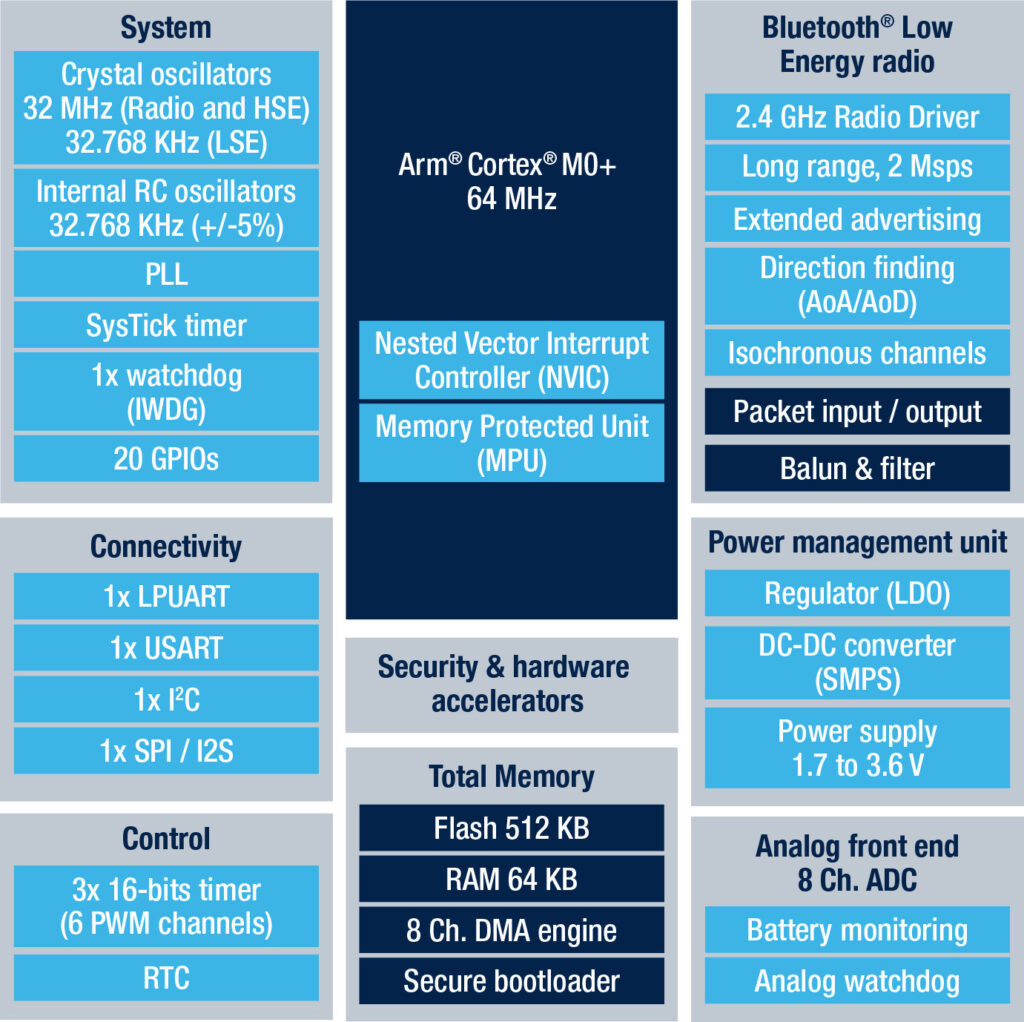ST is launching today the STM32WB09, thus inaugurating the STM32WB0 series and transitioning the latest generation of BlueNRG-LP(S) devices to the STM32Cube ecosystem. Architecturally, the STM32WB09 is a BlueNRG-LPS with 512 KB of flash instead of 192 KB to allow for more complex applications and an updated radio supporting all Bluetooth LE 5.2 hardware features.
However, in practical terms, the new device is ushering in a new ecosystem that marries existing solutions for STM32WBs and BlueNRGs to create a more productive and cohesive platform. For instance, the STM32WB0s will use the same Bluetooth stack as the BlueNRG-LP(S) while being a full member of the STM32Cube ecosystem. As of today, OEMs have exclusive access to the STM32WB09, and we already set public availability and support for the end of Q2 2024.
STM32WB09: What is happening?
The BlueNRG-LP(S) DNA

The STM32WB09 shares a lot of its DNA with the BlueNRG-LPS and, as such, uses the same Cortex-M0+ and Bluetooth stack. Integrators creating cost-effective and energy-sensitive solutions will thus inherit the BlueNRG modular software stack geared toward memory footprint optimizations and performance. The stack also stands out thanks to its interoperability and maturity. Similarly, developers enjoy the same advertising extensions, 2 Mbps high-speed, 1.3 km (0.8 miles) unobstructed long-range, and angle of arrival (AoA) or departure (AoD) calculations for position tracking. Moreover, even if engineers benefit from new features, like Isochronous Channels (more on that later), they can still reuse some of the BlueNRG-LPS PCB reference designs.
ST is committing to bringing the existing BlueNRG-LP and BlueNRG-LPS to the new STM32WB0 series. The choice to release the STM32WB09 first stems from a desire to reach partners that are content with the processing capabilities of the BlueNRG-LP(S) but need the memory afforded by some of the dual-core STM32WBs. They work on entry-level applications or energy-sensitive systems that demand the lower power consumption of the BlueNRG-LPS. For instance, the typical current draw of the device in shutdown mode is only 8 nA or almost half that of an STM32WB55. The new STM32WB09 thus gives integrators the ability to enjoy tremendous power savings still while benefiting from vastly more memory.
Over time, ST will also bring some software tools and application demos from the BlueNRG ecosystem to STM32Cube. Customers have shared that some of those tools have helped them optimize their workflow, and we want to ensure that the transition doesn’t rob them of the tools they’ve been relying on. Put simply, we are creating a unified portfolio to ensure developers can move up and down the price-per-performance ladder more easily, making this announcement a pivotal moment for our community.
The STM32Cube ecosystem promised land
While we are working on a unified experience, one of the challenges will be to create a cohesive ecosystem that enables developers to port their code from one device to another seamlessly. Similarly, such a massive software transition demands careful planning and extensive support to avoid breaking projects. It’s why we are first working with OEMs and ask that customers contact their ST representative. Working directly with developers will ensure a more efficient transition and smoother experience before we make the STM32WB09 and its STM32Cube ecosystem support available to all.
Why is this happening?
The success of the STM32WB
The announcement of the first STM32WB in 2018 was so significant that it disrupted high-end Bluetooth applications. For the first time, the radio and the Cortex-M0+ core driving the wireless stack sat right next to a Cortex-M4, thus allowing developers to create vastly more powerful applications without blowing up their bill of materials. For instance, the Jammy E guitar-shaped MIDI controller wouldn’t have been possible without the STM32WB running the Bluetooth MIDI profile. In fact, the idea of an all-in-one solution became so appealing that we released the STM32WB5MMG soon after. The module houses an STM32WB55, the antenna, baluns, and crystals, further facilitating the creation of powerful Bluetooth systems.
Making cost-effective Bluetooth applications accessible to all
Early this year, we released the STM32WBA, the first wireless Cortex-M33, thus showing our desire to provide powerful and secure systems since the STM32WBA opens the door to a SESIP Level 3 certification. However, teams looking to create more cost-effective solutions significantly favored BlueNRG. The SoCs remain popular, and ST just updated its portfolio to release the smallest BlueNRG-LPS yet at only 6.9 mm2 without compromising features or its +8 dBm power, making them one of the best price-per-feature ratio in the industry. Today’s STM32WB0 series is thus a testament to the success of the BlueNRGs and the STM32WBs as it harmonizes our portfolio while keeping our extensive price umbrella.
The fact that the STM32WB09 also showcases a Bluetooth LE 5.3-certified radio means that engineers get to enjoy features like Isochronous Channels, a new PHY layer that enables more complex data streams by ensuring the transmission of time-sensitive and synchronized information. However, more than adding to a list of specifications, the Bluetooth LE 5.2 radio is symbolic because it shows that besides being cost-effective, like the BlueNRG-LP(S) the STM32WB09 is also cost-competitive like the STM32WBs. Hence, more than a rebranding, the STM32WB09 is a new beginning for the engineers working on Bluetooth applications.







